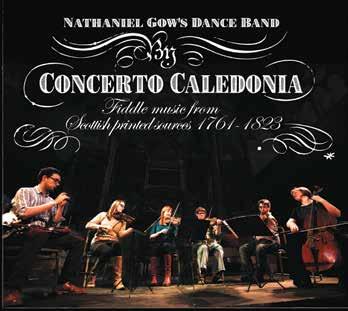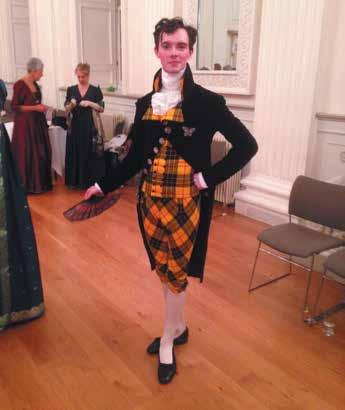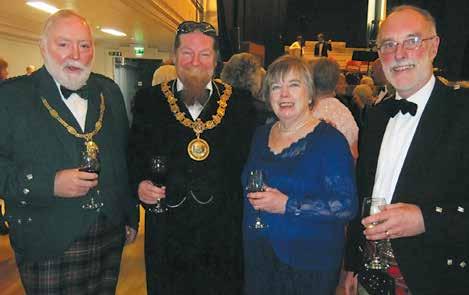
9 minute read
Nathaniel Gow's Dance Band
One of the original aims of the RSCDS was to ‘preserve and practise the traditional country dances of Scotland’. In Scotland today there are music and dance specialists, outwith the Society, going back to original sources. Jimmie Hill reports on three significant events, recently held in Edinburgh.
Concert, workshop and ball

Stuart Marsden calling the dances at the Nathaniel Gow Ball. Photo courtesy of Juliette Lichman
On Friday 20 January in the Assembly Rooms, Edinburgh, a concert took place in the very room and exactly 200 years to the day when Nathaniel Gow introduced quadrilles direct from Paris. The main hall in the recently restored Edinburgh Assembly Rooms is one of the largest and finest 18th century ballrooms in the UK. An ensemble consisting of two fiddlers, a cellist and a player of the small pipes, known as Nathaniel Gow’s Dance Band, played as dancers from Les Danses Antiques danced a quadrille and five 18th century country dances in period costume: Vertigo, The New Town of Edinburgh, The Wives of Kilwinnon, Kheellum Khallum taa fein and Sailor Lassie. The New Town of Edinburgh is the only one in the RSCDS repertoire. The following day the well-known historical dance specialist from London, Stuart Marsden, taught a 3-hour quadrille workshop with 70 dancers. Stuart was responsible for the dance scenes in the recent BBC series, Poldark. On 11 March, again 200 years to the day, chandeliers aglow and with everyone in period costume, Nathaniel Gow’s Dance Band played for a Regency Ball in the Assembly Rooms. Dancers came from all over the UK and Europe, with Stuart Marsden calling the quadrilles in French. We danced four country dances and Gow’s First, Second and Third Sets of Quadrilles, all to original unamplified music. Spectacular is the only word to describe it.
The Quadrille
By 1815 Britain was war-weary. We had been at war on and off for more than 20 years. Many women had suffered badly as their menfolk were away fighting. The well-off had been starved of their luxuries: French wine, brandy, and silks. But news had reached even Edinburgh that during the Revolution a new dance tradition – the quadrille – had developed in Paris. After Waterloo, English, Scottish and Irish dance masters crossed the Channel to experience this first-hand, attending the classes of the best Parisian teachers. They brought back the new steps, formations, dances and dance manuals. Quadrillemania swept the country. It was a new dance for a new era. So, why should we be interested in quadrilles today? A very brief summary of what we have inherited from the quadrille tradition includes: l a clear definition using ballet terms of the chassée step, the one we call skip change l a clear description of the original pas de basque step l the country dance in a square set l the ladies’ chain clearly defined l rights and lefts clearly defined l the grand chain
Dance style
One of the most interesting features in the country dance demonstrations was the dance style. Miss Milligan and her contemporaries decided that we would hold our arms at around shoulder height. Contemporary illustrations of the 18th century show arms down and this was how the dancers danced. Another major difference was the use of skip change in circles. The decision to use slip step dates to 1923. Another difference was that when leading down the middle and back, nearer hands were used. In Country Dancing Made Plain and Easy, London, 1764, ‘to lead down, the couple so doing must turn their faces towards the bottom of the dance, the man taking the woman’s right hand in his left, and so moving forwards.’ Our leading with right hand in right hand also dates from 1923. The dance we dance as a strathspey, The New Town of Edinburgh, was danced to its original tune as a hornpipe. The dance begins with the 1st and 2nd couples setting and crossing over. Robert Bremner’s 1761 instructions say, ‘The first and second couple foot it and change sides.’ ‘Footing’ is described in the 1764 manual as an alternative word to ‘setting’ and means ‘moving the foot behind close to the other and hopping, being careful to move yourself as little backwards with it as possible’, and this is what the dancers did – as far from our setting as one could imagine! It was fascinating to watch non-RSCDS trained dancers looking afresh at a tradition we think of as our own.
Nathaniel Gow (1766 – 1831)
All three events this year highlight the huge importance of Nathaniel Gow. Born near Dunkeld, the youngest son of Niel Gow, Nathaniel is arguably the most important figure in the history of country dancing in Scotland. In his Biographical Dictionary of the most Eminent Scotsmen, published in 1835, Robert Chambers writes that it is ‘difficult to describe the influence, success, and reputation of Nathaniel . . . He is considered the most eminent of (Niel’s) sons for advancing the cause and popularity of our national music.’ He studied the violin under his father Niel, Robert McIntosh and Alexander McGlashan, as well as the cello under Joseph Reneagle, later Professor of Music at Oxford University. For 40 years from 1791 his band was the foremost dance band in Scotland. In 1796 he supplements this by opening a music shop in Edinburgh selling both music and musical instruments. Meanwhile, his brother John moved to London and had his own Scottish band. Between them the Gow brothers played at the most important dance assemblies in both Scotland and England. Nathaniel frequently visited London. George IV would invite him to play for him – the king himself joining the band as cellist. At the height of his popularity it was said that Nathaniel was worth £20,000 – well over a million in today’s money. Modern bands – and RSCDS branch treasurers – would be shocked that he was usually paid 100 – 150 guineas to play. That would be in the region of £7000 today. Apart from his many iconic publications, it was said of his playing that ‘he had all the fire and spirit of his father in the quick music, with more refined taste, delicacy and cleanness of intonation in the slow and plaintive melodies.’ Chambers gives his most popular tunes as: Callar Herring, Sir George Clark, Lady Charlotte Durham, the Miller of Drone, Largo’s Fairy Dance, and Mrs Wemyss of Castlehill. Every year he held a ball in the Edinburgh Assembly Rooms, ‘attended by all the fashionable and wealthy of the country’. This was the inspiration for the Ball on March 11.
Scottish or English?
Was this Scottish country dancing? Today the two national traditions have diverged, but in the late 18th and early 19th centuries the country dance was still evolving. Francis Peacock of Aberdeen had ‘the advantage of a regular tuition under the best Masters in London’, according to his obituary in the Aberdeen Journal (8 July 1807). The dances which were danced in London and Bath would be danced in Edinburgh, Dumfries and Inverness and vice versa. John Gow played both Scottish and English music in London as Nathaniel did in Edinburgh. John introduced Scottish tunes into London quadrille dancing. Nathaniel used French and classically-inspired tunes in Edinburgh. Cross-fertilisation between Scotland and London was the norm.
Concerto Caledonia
One of the most exciting elements of this year’s Gow events was the playing of Nathaniel Gow’s Dance Band, drawn from the established ensemble, Concerto Caledonia. The lead fiddler in the band, Aaron McGregor, is a final year PhD student at Glasgow University, studying the early history of the violin in Scotland. Aaron believes the two things people notice about their style of playing are the bass-lines and the lack of harmony instruments. They use period instruments, set up as they would have been around 1770. It’s a much simpler sound than we are used to today without anyone vamping chords. They have tried to bring together traditional fiddlers as well as people with an Early Music background – Marie Fielding on fiddle, Alison McGillivray on cello and Callum Armstrong on the small pipes and baroque recorder. Their playing style has grown out of the material from the early collections.
During the 18th century a country dance band would play only the one tune for a dance, whereas we are used to several after the socalled ‘original’. At the concert Aaron mentioned that Nathaniel Gow was one of the first to use medleys of different tunes and tempos. He is of the view there is so much more source material in libraries which has not been looked at. The work which the RSCDS has done on the historic repertoire was all done in the pre-digital age when you had to go in person and dig around in different libraries. Today you can use search engines and find manuscripts and cross-reference much more easily. It will be interesting to see whether the work which researchers outwith the RSCDS are now doing may inspire us to curate the heritage and look again at what we have not published. Aaron and his colleagues are currently introducing this historical material to the wider traditional music world both here in Scotland and abroad. He maintains that in order to re-imagine what this ‘sound world’ was, there is a lot of research still to be done. When asked what was different when you take a Bremner or Gow fiddle tune and play it on the piano, his view is that it is a very different world and you lose something of the original style as soon as you add chords. When you listen to Aaron and his colleagues, you have to forget your preconceptions about what Scottish dance music sounds like and listen with new ears.


Mr Zack Macleod Pinsent from Brighton resplendent in Macleod tartan at the Regency Ball
Talitha Mackenzie
The driving force behind the Gow weekend and Ball was the ethnomusicologist, Talitha MacKenzie, originally from New York, but living in Edinburgh for 30 years. She has been interested in historical dance since she was a teenager; she is on the Board of the Historical Dance Society (formerly the Dolmetsch HSDS); and teaches historical dance at the Royal Conservatoire of Scotland in Glasgow. Along with Stuart Marsden, she has worked on reconstructing the three Gow quadrilles for the Ball; she has recorded the music in advance for all the dancers attending. She rightly deserves to be recognised for organising what has been a unique series of events, celebrating the great Nathaniel Gow, the very important quadrille tradition, and bringing unpublished country dances to everyone’s attention, marrying authentic music and dance. Before writing this article I met Aaron McGregor and David McGuiness of the Music Department of Glasgow University. David made the very valid distinction between history and tradition. History looks at historical documents which cannot change. Tradition, on the other hand, is always changing. Perhaps in the RSCDS we need to think about how we have changed and continue to change tradition.
References:
Biographical Dictionary of the most Eminent Scotsmen, Robert Chambers 1835. For dance and music sources go to hms.scot For Nathaniel Gow’s Dance Band go to concal.org to hear what Nathanial Gow’s Dance Band sounds like, to see where they are playing next and to buy their CD. For more information on next year’s ball, contact info@sonasmultimedia.co.uk










